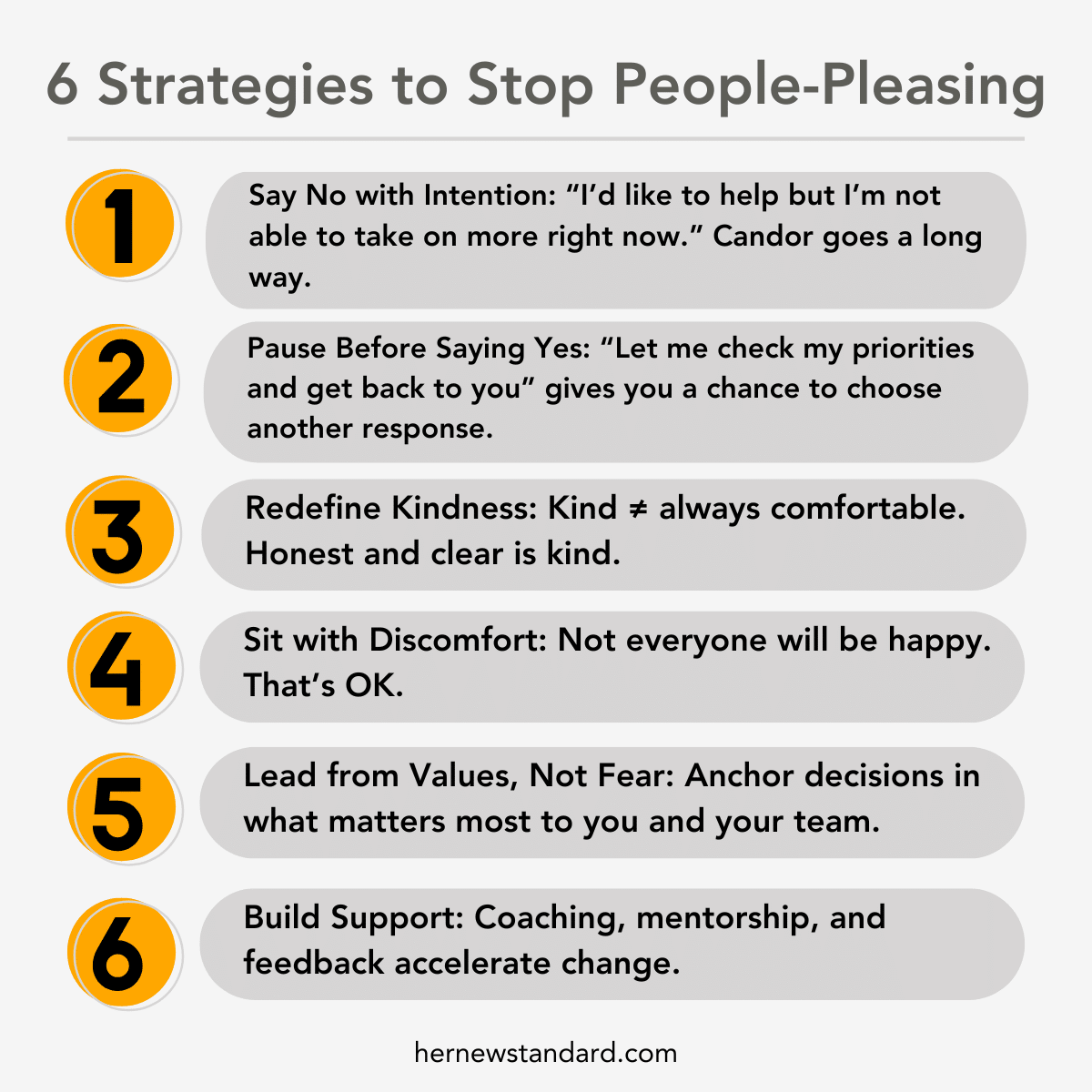Are you constantly saying “yes,” taking on extra work, avoiding conflict, or putting your needs last to keep the peace? You’re not alone, but you are putting your leadership at risk. People-pleasing is one of the most overlooked leadership pitfalls. It’s quiet, it’s subtle, and it slowly erodes your influence, effectiveness, and well-being.
In a YouGov poll, 49% of adults identified as people-pleasers, revealing just how common this behavior is, especially in today’s culture where being likable is often prized over being clear or direct.
And the toll is real: The American Psychological Association’s 2023 Work in America Survey found that 77% of employees feel stressed at work, with lack of boundaries and excessive workload among the top drivers.
At Her New Standard, we see high-achieving leaders struggle with this all the time. They want to be supportive and collaborative, but their drive to be liked or avoid discomfort often backfires, hurting their effectiveness, their teams, and ultimately the whole organization.
In this article, we’ll unpack what people-pleasing really looks like in leadership, why it happens, and most importantly, how to break free so you can lead boldly without losing your edge or compromising your organization’s success.
What Is People-Pleasing?
People-pleasing is the habit of putting others’ needs, opinions, or feelings ahead of your own, usually to keep the peace, avoid conflict, or seek approval. In leadership, it can show up as saying yes when you should say no, dodging tough conversations, or stepping in too often instead of letting your team take the lead.
One senior leader we worked with constantly jumped in to “save the day” when her team hit roadblocks. While her intentions were good, this habit led to burnout and created dependency. Over time, her team stopped taking initiative, and she became a bottleneck. What seemed like support was actually people-pleasing. It sabotaged her impact and her team’s growth.
While collaboration and empathy are essential leadership traits, people-pleasing takes them to an unhealthy extreme. It leads to blurred boundaries, mental exhaustion, and missed opportunities to lead with clarity and confidence.
7 Signs You May Be a People-Pleaser at Work
People-pleasing at work isn’t always obvious. It often hides behind behaviors that look like dedication or helpfulness. But if you find yourself doing any of the following regularly, it may be a sign that people-pleasing is holding you back:
- You apologize even when you haven’t done anything wrong.
- You struggle to say no, even when your plate is full.
- You take on extra work to avoid disappointing others.
- You avoid conflict at all costs.
- You crave external validation to feel successful.
- You feel anxious when others are upset with you.
- You feel depleted, even though you “did everything right.”
While these behaviors may seem like signs of commitment, over time they reduce your leadership effectiveness. You become reactive rather than intentional, and your team may start to rely on your overextension instead of developing their own capabilities.
What Causes People-Pleasing (Especially in Leaders)?
People-pleasing often starts early. It’s a learned pattern that many of us carry into adulthood, including into leadership roles. For leaders, the pressure to be liked or to avoid being labeled “too assertive” can feel intense. This struggle is even more pronounced for women and other underrepresented groups, who frequently face unfair double standards about how authority should look and sound.
But it’s not just about individual habits. Organizational culture plays a huge role, too. Workplaces that reward over-functioning, sidestep tough conversations, or fail to create psychological safety can unintentionally push leaders to stretch themselves too thin, prioritizing others’ needs at the expense of their own goals and effectiveness.
One executive we coached recalled being told early in her career to “never be the difficult woman in the room.” That belief followed her into leadership. She avoided disagreement, downplayed her ideas, and took on extra work to seem agreeable. Her people-pleasing wasn’t a personality quirk. In truth, it was a survival strategy shaped by culture and experience.
How People-Pleasing Hurts Teams, Culture, and Results
People-pleasing isn’t just a personal problem. It has ripple effects throughout the organization:
- Burnout: Leaders who say yes to everything often burn out, leading to disengagement or turnover.
- Ineffective Delegation: When leaders over-function, they rob their teams of opportunities to stretch and grow.
- Avoiding Accountability: People-pleasing leaders may avoid hard conversations, leading to unclear expectations and underperformance.
- Cultural Impact: Over time, the team may mirror these behaviors, creating a culture of overwork and under-communication.
For example, we worked with a manager who avoided giving constructive feedback because she didn’t want to seem “harsh.” Performance issues lingered, targets were missed, and the team grew frustrated. When she finally addressed the issues directly, with support and clarity, her credibility soared and so did her results.
People-pleasing can look like being a “team player,” but it actually erodes leadership credibility and dilutes impact.
6 Strategies to Stop People-Pleasing and Lead with Clarity
Shifting away from people-pleasing requires developing new habits and a mindset reset. These six practical strategies will help you build the confidence and boundaries essential for clear, purposeful leadership:
- Say No with Intention: “I’d like to help but I’m not able to take on more right now.” Candor goes a long way.
- Pause Before Saying Yes: “Let me check my priorities and get back to you” gives you a chance to choose another response.
- Redefine Kindness: Kind ≠ always comfortable. Honest and clear is kind.
- Sit with Discomfort: Not everyone will be happy. That’s OK.
- Lead from Values, Not Fear: Anchor decisions in what matters most to you and your team.
- Build Support: Coaching, mentorship, and feedback accelerate change.
Individually, these shifts may seem small. But together, they can reshape your leadership approach, reduce your stress and create a healthier and more effective culture.
High-Impact Leadership Starts with Boundaries
You’re not leading to win a popularity contest. You’re leading to make an impact. That means setting boundaries, making hard calls, and staying focused on what really matters.
When you let go of people-pleasing, you create the space to lead with greater intention, courage, and influence. Remember that setting clear boundaries is strategic, not selfish. It protects your energy, sharpens your focus, and sets the tone for your team. When leaders model this kind of clarity, it empowers others to do the same. Teams become more accountable. Communication becomes more direct. Culture becomes more resilient.
It’s time to lead with intention, not seek approval.
Enjoyed this post? You might also like…





